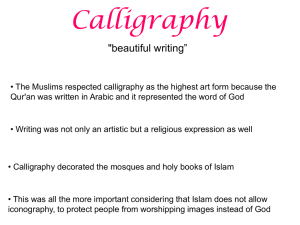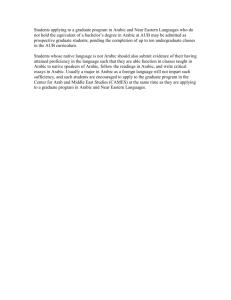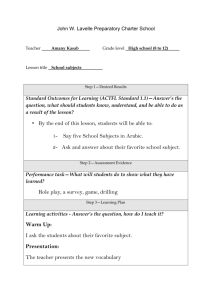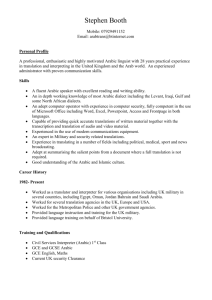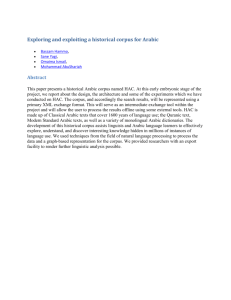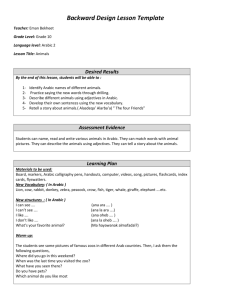Historic and Contemporary Approaches to Arabic Calligraphy
advertisement
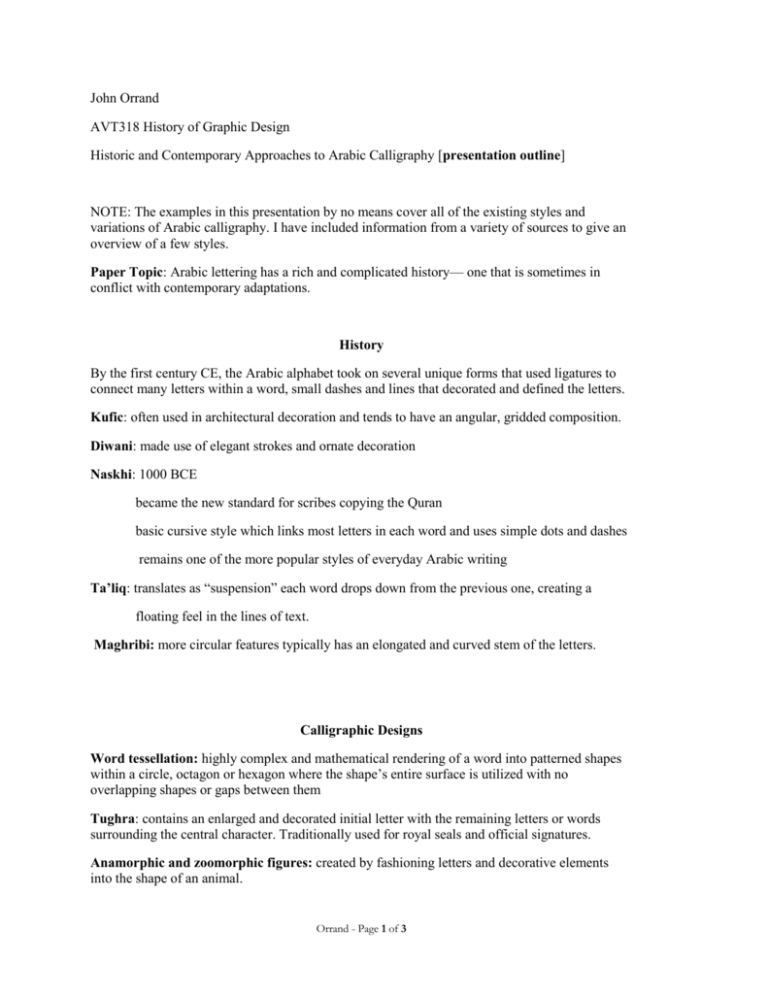
John Orrand AVT318 History of Graphic Design Historic and Contemporary Approaches to Arabic Calligraphy [presentation outline] NOTE: The examples in this presentation by no means cover all of the existing styles and variations of Arabic calligraphy. I have included information from a variety of sources to give an overview of a few styles. Paper Topic: Arabic lettering has a rich and complicated history— one that is sometimes in conflict with contemporary adaptations. History By the first century CE, the Arabic alphabet took on several unique forms that used ligatures to connect many letters within a word, small dashes and lines that decorated and defined the letters. Kufic: often used in architectural decoration and tends to have an angular, gridded composition. Diwani: made use of elegant strokes and ornate decoration Naskhi: 1000 BCE became the new standard for scribes copying the Quran basic cursive style which links most letters in each word and uses simple dots and dashes remains one of the more popular styles of everyday Arabic writing Ta’liq: translates as “suspension” each word drops down from the previous one, creating a floating feel in the lines of text. Maghribi: more circular features typically has an elongated and curved stem of the letters. Calligraphic Designs Word tessellation: highly complex and mathematical rendering of a word into patterned shapes within a circle, octagon or hexagon where the shape’s entire surface is utilized with no overlapping shapes or gaps between them Tughra: contains an enlarged and decorated initial letter with the remaining letters or words surrounding the central character. Traditionally used for royal seals and official signatures. Anamorphic and zoomorphic figures: created by fashioning letters and decorative elements into the shape of an animal. Orrand - Page 1 of 3 Contemporary Use *Because Arabic calligraphy is rooted in the Islamic religion and its texts, the Arabic letterform and calligraphic styles are considered by many to be holy and sacred and stands as a symbol for Islamic culture. Modern use sometimes stands in conflict with its origins. All Arabic calligraphy is considered Tawqif, or the “language established by God”. Quotes: Alia Hasan, a researcher of Arabic art and architecture, states, “to Muslims, calligraphy is used as the ultimate expression of God’s words.” Baba Shah Isfahani, author of a Persian treatise in the seventeenth century, claimed, “the practice of the calligraphic art requires moderation and balance of the soul, without which the expression of the divine beauty with pen and ink becomes flawed.” Huda Smitshuijzen AbiFares, an expert on Arabic typography, states, “when Arabic type is applied to situations where order and clarity prevail -such as newspapers, signage, on-line... etc. it is often stripped totally of its beauty and rendered sterile.” Closing: perhaps the best practice for modern designers would be to make every effort to preserve its fundamental standards by being conscious of the complex tradition associated with Arabic calligraphy. Orrand - Page 2 of 3 Works Cited AbiFares Huda Smitshuijzen, Arabic Type: a challenge for the 2nd millennium, 1998 http://www.sakkal.com/articles/Arabic_Type_Article/Arabic_Type1.html Ahuja, Mangho and A. L. Loeb Leonardo, Tessellations in Islamic Calligraphy, Vol. 28, No. 1 (1995), pp. 41-45 Published by: The MIT Press Beumer, W.G.M., Experimental Arabic type designs: breaking away from a rich tradition, Library of the University of Amsterdam, http://www.uba.uva.nl/news/object.cfm De Zoysa, Dana, Splendor in the Line, http://januarymagazine.com/artcult/islamcalig.html Ernst, Carl W., The Spirit of Islamic Calligraphy: Bābā Shāh Iṣfahānī's Ādāb al-mashq, Journal of the American Oriental Society, Vol. 112, No. 2 (Apr. - Jun., 1992), pp. 279-286 Published by: American Oriental Society Ghulam, Dr. Yousif Mahmud, The Art of Arabic Calligraphy, 2nd ed, 1982 ,Published by the author Hasan, Alia F., Arabic Calligraphy: The Art of the Calligraphy Scripts in Islamic History http://www.suite101.com/article.cfm/arabic_islamic_architecture/28162 Khallaf, Rania, Calligraphy remembered http://weekly.ahram.org.eg/2001/565/fe5.htm Roxburgh, David J., On the Transmission and Reconstruction of Arabic Calligraphy: Ibn al-Bawwab and History Studia Islamica, No. 96, Écriture, Calligraphie et Peinture (2003), pp. 39-53, published by Maisonneuve & Larose Schimmel, Barbar Rivolta, Islamic Calligraphy, The Metropolitan Museum of Art Bulletin, New Series, Vol. 50, No. 1, Islamic Calligraphy (Summer, 1992), pp. 1-56 Zeina Azzam Seikaly, The Arabic Language: The Glue ThatBinds the Arab World http://www.amideast.org/publications/arabic-language.pdf Other Sources Atiyeh, George N., The book in the Islamic world: the written word and communication in the Middle East, http://www.netlibrary.com.mutex.gmu.edu/Reader [electronic resource] Bell, Roanne. Symphonic Scripts, Print magazine, Aug 08 Margaret M. Wood, Latinizing the Turkish Alphabet: A Study in the Introduction of a Cultural Change, The American Journal of Sociology, Vol. 35, No. 2 (Sep., 1929), pp. 194-203 Millican, Richard D. Reviewed work(s): Lettering. The History and Technique of Lettering and Design by Alexander Nesbitt The Journal of Marketing, Vol. 15, No. 4 (Apr., 1951), pp. 510-511 Smart, J.R., Tradition and modernity in Arabic language and literature, Richmond, Surrey, U.K. : Curzon Press, 1996. Orrand - Page 3 of 3
